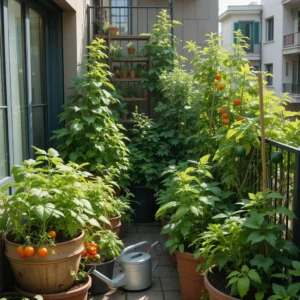
Indoor plants do more than just beautify your space; they actively improve air quality by filtering harmful toxins and increasing oxygen levels. With pollution levels rising and indoor air quality becoming a growing concern, having air-purifying plants in your home or office is a natural and effective way to breathe cleaner air. This article explores the top indoor plants for clean air, their benefits, and how to care for them to ensure maximum effectiveness.
Why Indoor Plants Are Essential for Clean Air
1. Removes Toxins from the Air
NASA’s Clean Air Study found that certain houseplants can remove up to 87% of airborne toxins within 24 hours. Harmful chemicals like benzene, formaldehyde, trichloroethylene, xylene, and ammonia are commonly found in household items, and plants help filter them out.
2. Increases Oxygen Levels
Plants absorb carbon dioxide and release oxygen during photosynthesis. Some plants even continue oxygen production at night, making them perfect for bedrooms.
3. Improves Humidity
Indoor plants increase moisture levels in the air, which can prevent issues like dry skin, irritation, and respiratory problems.
4. Boosts Mental Well-Being
Studies show that having plants indoors reduces stress, enhances mood, and improves concentration. They create a calming atmosphere and can even boost productivity in workspaces.
Top 10 Indoor Plants for Clean Air

1. Spider Plant (Chlorophytum comosum)
- Air-Purifying Benefits: Removes carbon monoxide, formaldehyde, and xylene.
- Care Tips: Thrives in indirect sunlight and needs watering once a week.
2. Snake Plant (Sansevieria trifasciata)
- Air-Purifying Benefits: Absorbs toxins like benzene and trichloroethylene; releases oxygen at night.
- Care Tips: Low maintenance; tolerates low light and minimal watering.
3. Peace Lily (Spathiphyllum)
- Air-Purifying Benefits: Filters formaldehyde, benzene, and ammonia.
- Care Tips: Prefers shade and weekly watering; toxic to pets.
4. Aloe Vera
- Air-Purifying Benefits: Removes formaldehyde and benzene; also has medicinal benefits.
- Care Tips: Needs bright, indirect sunlight and occasional watering.
5. Boston Fern (Nephrolepis exaltata)
- Air-Purifying Benefits: Adds humidity while filtering toxins.
- Care Tips: Requires frequent watering and indirect light.
6. Areca Palm (Dypsis lutescens)
- Air-Purifying Benefits: Removes airborne toxins and increases humidity.
- Care Tips: Needs bright, indirect sunlight and moderate watering.
7. Rubber Plant (Ficus elastica)
- Air-Purifying Benefits: Absorbs toxins and reduces mold spores.
- Care Tips: Prefers indirect light and occasional watering.
8. Dracaena (Dracaena spp.)
- Air-Purifying Benefits: Eliminates benzene, trichloroethylene, and xylene.
- Care Tips: Needs moderate light and occasional watering.
9. Bamboo Palm (Chamaedorea seifrizii)
- Air-Purifying Benefits: One of the best plants for filtering formaldehyde and carbon monoxide.
- Care Tips: Thrives in indirect light and requires regular watering.
10. Golden Pothos (Epipremnum aureum)
- Air-Purifying Benefits: Absorbs toxins like benzene, formaldehyde, and xylene.
- Care Tips: Extremely easy to care for; thrives in low light.
How to Maximize the Air-Cleaning Benefits of Indoor Plants

1. Use Multiple Plants
Experts recommend having at least one plant per 100 square feet for noticeable air purification.
2. Choose the Right Placement
Place plants in areas with poor air circulation, such as near electronics, in bedrooms, and in offices.
3. Keep Leaves Clean
Dust accumulates on leaves, reducing their ability to purify air. Wipe them down weekly to keep them effective.
4. Maintain Proper Care
Each plant has unique care needs. Overwatering and under-watering can reduce their ability to clean air.
5. Combine Different Plant Types
Some plants are better at removing specific toxins. A mix of different plants ensures a broader range of air purification.
FAQs About Air-Purifying Indoor Plants
1. Which indoor plant is best for improving air quality?
The Spider Plant, Snake Plant, and Peace Lily are among the best air-purifying indoor plants.
2. How many indoor plants do I need for clean air?
NASA suggests having 1 plant per 100 square feet for effective air purification.
3. Are indoor plants safe for pets?
Some plants, like Peace Lilies and Rubber Plants, can be toxic to pets. Opt for pet-friendly choices like Areca Palms and Spider Plants.
4. Do plants really improve indoor air quality?
Yes! Studies confirm that certain plants absorb toxins and improve air quality.
5. Can air-purifying plants replace air purifiers?
While plants help, they shouldn’t fully replace an air purifier, especially in highly polluted areas.
Investing in air-purifying indoor plants is an easy and natural way to boost air quality, improve well-being, and create a greener home environment. From low-maintenance Snake Plants to humidity-boosting Boston Ferns, there’s an option for everyone. Start incorporating these plants into your home today and enjoy cleaner, fresher air!



